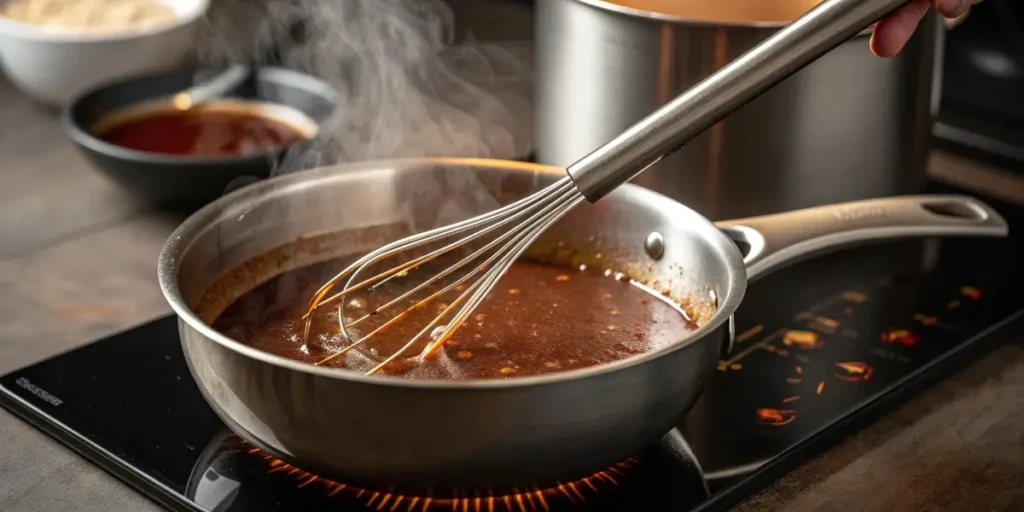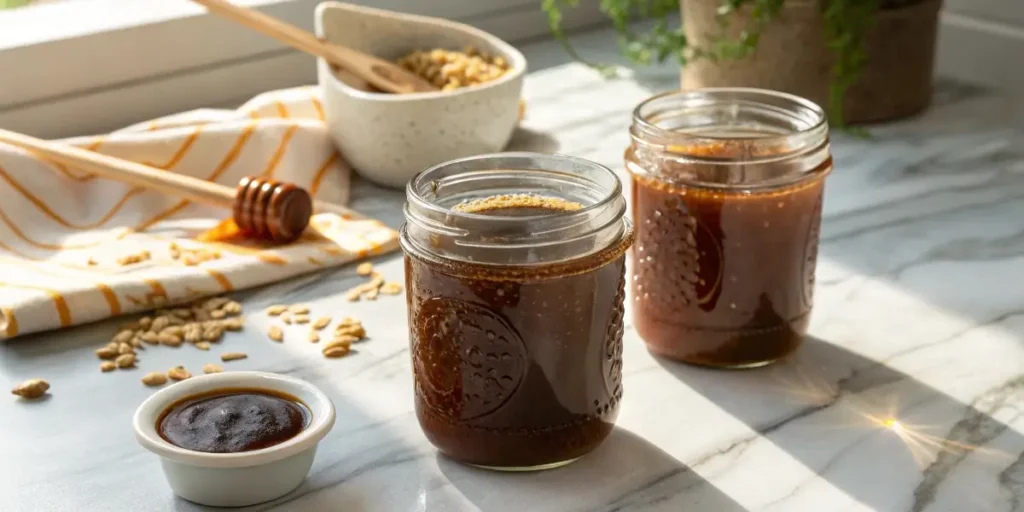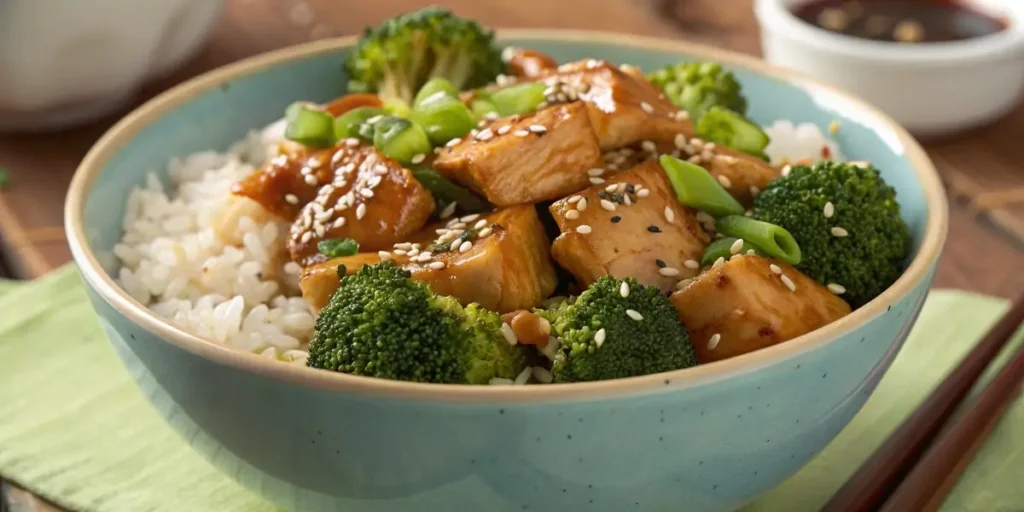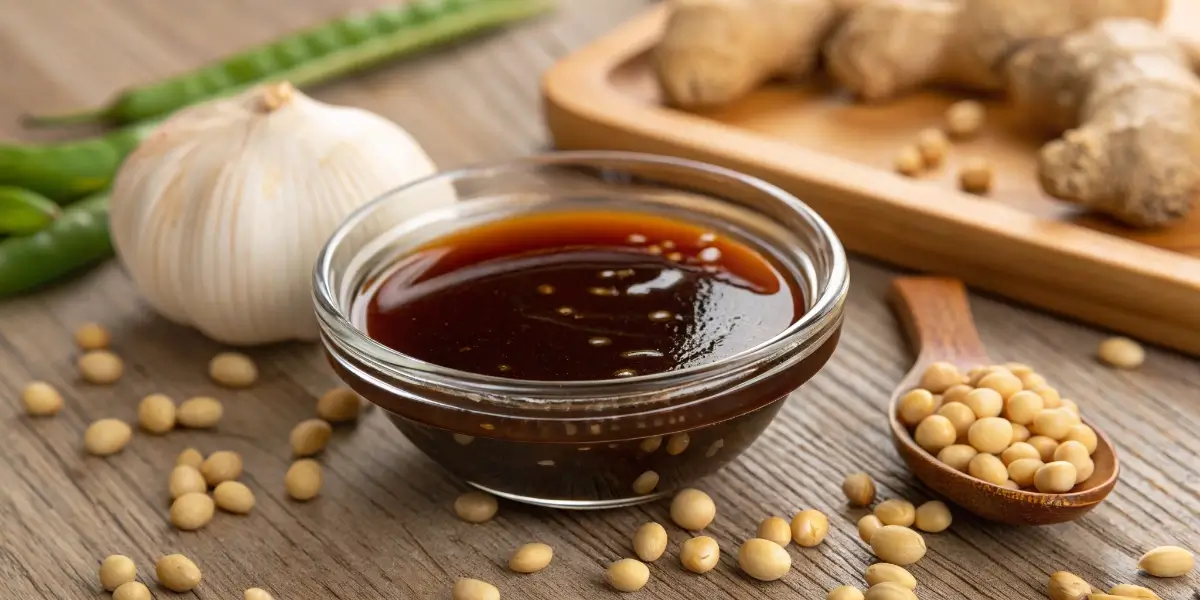Gluten Free Teriyaki Sauce: The Ultimate Guide to Flavor Without Gluten
Few sauces deliver the irresistible sweet-salty balance that teriyaki does. But for anyone avoiding gluten, finding (or making) the right teriyaki sauce can feel tricky. Traditional versions usually rely on soy sauce that contains wheat, which isn’t safe for those with celiac disease or gluten intolerance. Fortunately, gluten free teriyaki sauce offers the same glossy texture and rich umami flavor—without the gluten risk.
In this guide, you’ll discover exactly what makes teriyaki sauce gluten-free, the best substitutes, how to make your own sauce from scratch, and how to use it in your favorite meals. You’ll also learn how to choose safe store-bought brands, store homemade batches properly, and get expert answers to common FAQs.
Looking for inspiration? Try our Gluten-Free Side Dishes for perfect meal pairings.
Table of Contents
Understanding Gluten in Teriyaki Sauce
What Is Teriyaki Sauce and Its Traditional Ingredients
Teriyaki sauce originated in Japan and became a global favorite for its shiny glaze and bold flavor. Traditionally, it’s made with soy sauce, mirin (a sweet rice wine), sugar, and sometimes sake. These ingredients combine to create a sauce that caramelizes beautifully over grilled meats, fish, or vegetables.
However, classic soy sauce is the main source of gluten in traditional recipes. Most commercial soy sauces contain wheat, which gives them a mellow taste but makes them unsuitable for gluten-free diets. While a few Japanese brands offer wheat-free options, they’re not always labeled clearly, which leads to confusion for gluten-sensitive consumers.
Many people assume all soy sauce is safe, but unless the label specifically says “gluten-free,” it almost certainly contains wheat. That’s why reading ingredient lists and certifications is essential before purchasing or preparing any teriyaki-style sauce.
Why Regular Teriyaki Sauce Often Contains Gluten
The biggest culprit in non-gluten free teriyaki sauce is soy sauce, but it’s not the only one. Some bottled teriyaki sauces also include malt vinegar, barley extracts, or thickeners derived from wheat flour. These additives help achieve a glossy finish but introduce gluten.
To make matters more confusing, many sauces don’t openly list gluten-containing ingredients. Instead, they may use ambiguous terms like “hydrolyzed wheat protein” or “natural flavoring,” which can still contain gluten traces. That’s why gluten free teriyaki sauce recipes rely on tamari, a soy-based but wheat-free alternative, or coconut aminos, which are naturally gluten-free and slightly sweeter.
If you’re living a gluten-free lifestyle, knowing these ingredient distinctions can help you avoid cross-contamination and enjoy the deliciousness of teriyaki sauce safely.
What Makes a Teriyaki Sauce Gluten-Free
Key Gluten-Free Substitutes for Soy Sauce and Mirin
When crafting a truly gluten-free teriyaki sauce, the key lies in the ingredients that replace traditional soy sauce and mirin. Most standard soy sauces are made with both soybeans and wheat, which introduces gluten. The easiest fix is tamari, a Japanese-style soy sauce made without wheat. Tamari has a rich umami flavor similar to regular soy sauce but is smoother and less salty—making it ideal for gluten-free cooking.
Another popular alternative is coconut aminos, made from the fermented sap of coconut blossoms. It’s naturally gluten-free, soy-free, and has a mild sweetness that balances perfectly with garlic and ginger. For sweetness, you can swap mirin with a mix of rice vinegar and honey or maple syrup, creating that same glossy finish found in traditional teriyaki recipes.
Here’s a quick comparison table of gluten-free substitutes:
| Ingredient | Gluten-Free Alternative | Flavor Notes |
|---|---|---|
| Soy Sauce | Tamari / Coconut Aminos | Savory, rich umami |
| Mirin | Rice Vinegar + Honey | Mildly sweet and tangy |
| Wheat Flour Thickener | Cornstarch / Arrowroot | Smooth, glossy texture |
These small swaps transform teriyaki sauce into a gluten-free, allergy-friendly condiment that doesn’t compromise on flavor.
How to Read Labels to Ensure a Truly Gluten Free Teriyaki Sauce
Even when a sauce claims to be gluten-free, reading labels is a must. Manufacturers sometimes process products in facilities that handle wheat, leading to cross-contamination. Always look for certified gluten-free logos, which indicate testing and verification by third-party agencies.
Here’s what to check on your sauce label:
- Wheat-free statement: Ensure “contains wheat” is not listed under allergens.
- Certification: Look for the Gluten-Free Certification Organization (GFCO) or similar marks.
- Hidden gluten sources: Watch for vague ingredients like “modified food starch,” “malt extract,” or “hydrolyzed vegetable protein.”
Pro tip: Store-bought teriyaki sauces like Kikkoman Gluten-Free Tamari Teriyaki or Primal Kitchen No Soy Teriyaki are both safe and flavorful. You can also make a homemade version to avoid any uncertainty.
For another Asian-inspired gluten-free dinner, learn more about pairing it with creamy dishes like Gluten-Free Fettuccine Alfredo.
How to Make Homemade Gluten Free Teriyaki Sauce

Step-by-Step Recipe Using Simple Pantry Ingredients
Making your own gluten free teriyaki sauce at home is surprisingly easy—and it tastes fresher than anything you’ll find on a store shelf. Plus, you can control the sweetness, thickness, and sodium levels to suit your preferences.
Here’s a simple gluten free teriyaki sauce recipe that takes less than 15 minutes to prepare:
Ingredients:
- ½ cup tamari (gluten-free soy sauce alternative)
- ¼ cup water
- 2 tablespoons honey or maple syrup
- 1 tablespoon rice vinegar
- 1 tablespoon sesame oil
- 2 teaspoons fresh minced garlic
- 2 teaspoons grated ginger
- 1 tablespoon cornstarch mixed with 2 tablespoons cold water (for thickening)
Instructions:
- In a small saucepan over medium heat, combine tamari, water, honey, rice vinegar, sesame oil, garlic, and ginger. Stir well.
- Bring to a gentle simmer and cook for about 3–4 minutes to let the flavors blend.
- Add the cornstarch mixture and whisk continuously until the sauce thickens and becomes glossy—about 2 minutes.
- Taste and adjust sweetness or saltiness as needed.
- Let it cool slightly before using or store it in a jar in the fridge for up to 10 days.
This easy method creates a rich, shiny, and flavorful gluten-free teriyaki glaze that clings perfectly to chicken, salmon, tofu, or vegetables.
Cooking Tips for Perfect Texture and Balanced Flavor
The secret to nailing the best gluten free teriyaki sauce lies in the balance between saltiness, sweetness, and thickness. Here are a few pro tips:
- Use fresh aromatics: Fresh ginger and garlic provide a punch of flavor that bottled sauces can’t replicate.
- Don’t skip the cornstarch slurry: It’s key to getting that signature glossy coating without using flour-based thickeners.
- Simmer, don’t boil: Overheating can cause the sauce to separate or taste burnt. Keep the heat low for a silky texture.
- Customize the sweetness: For a deeper caramel flavor, try dark brown sugar or coconut sugar instead of honey.
- Double the batch: This sauce stores well and tastes even better after a day or two as the flavors meld.
Once you master this homemade recipe, you’ll never go back to store-bought versions again. It’s not just gluten-free—it’s cleaner, healthier, and irresistibly good.
For a creative twist, drizzle it over seafood using this guide: Gluten-Free Popcorn—a fun side dish that pairs beautifully with Asian-inspired meals.
Gluten-Free Alternatives and Substitutes
Best Store-Bought Gluten Free Teriyaki Sauces
If you don’t have time to whip up a homemade version, there are several ready-made gluten free teriyaki sauces that deliver authentic flavor without gluten. The market has expanded in recent years, offering plenty of safe and delicious options for people with celiac disease or gluten sensitivity.
Here are a few top-rated choices to try:
| Brand | Key Features | Notes |
|---|---|---|
| Kikkoman Gluten-Free Teriyaki Marinade & Sauce | Made with tamari instead of wheat-based soy sauce | Balanced salty-sweet flavor |
| Primal Kitchen No Soy Teriyaki Sauce | Soy-free, gluten-free, and paleo-friendly | Uses organic coconut aminos |
| San-J Gluten-Free Teriyaki | Certified gluten-free and non-GMO | Bold flavor perfect for grilling |
| Yo Mama’s Teriyaki | No added sugar, gluten-free | Great for stir-fries and marinades |
These sauces are excellent for busy weeknights when you need something quick yet flavorful. Always double-check the label before purchasing, as formulations can change.
For more inspiration, check out our Gluten-Free Summer Salads—perfect pairings for teriyaki chicken or tofu bowls.
DIY Substitutes for Teriyaki Sauce You Can Make Anytime
If you’re missing a key ingredient or prefer to customize flavors, here are easy gluten-free teriyaki substitutes you can mix up in minutes:
- Soy-Free Teriyaki Substitute:
Combine ¼ cup coconut aminos, 1 tablespoon honey, 1 teaspoon sesame oil, 1 clove minced garlic, and a splash of apple cider vinegar. Heat briefly until thickened. - Low-Sodium Version:
Use reduced-sodium tamari, skip the cornstarch, and sweeten with pineapple juice for a lighter glaze. - Vegan Teriyaki Sauce:
Replace honey with maple syrup or agave nectar to keep it fully plant-based and gluten-free. - No-Cook Option:
Whisk together tamari, rice vinegar, garlic powder, and ginger powder—ideal for quick marinades or dipping sauces.
Each of these variations maintains the signature balance of salty-sweet-umami flavors, giving you full control over ingredients and dietary needs. Whether you’re soy-free, vegan, or just mindful of your sodium intake, these substitutes make teriyaki accessible to everyone.
Health Benefits and Nutritional Insights

Is Gluten Free Teriyaki Sauce Healthier Than Regular?
When you switch to gluten free teriyaki sauce, you’re not just avoiding gluten—you’re often choosing a cleaner and lighter option. Many commercial sauces use refined sugar, wheat-based thickeners, and artificial preservatives that can add unnecessary calories and sodium. Gluten-free versions, especially homemade ones, tend to rely on whole, natural ingredients like tamari, coconut aminos, and honey, which can make them both tastier and better for you.
Here’s how gluten-free teriyaki compares to traditional sauce:
| Nutrient | Regular Teriyaki (2 Tbsp) | Gluten-Free Homemade (2 Tbsp) |
|---|---|---|
| Calories | 45–60 | 30–40 |
| Sodium | 600–700 mg | 400–500 mg |
| Sugar | 6–10 g | 4–6 g |
| Gluten | Yes | None |
As you can see, gluten free teriyaki sauce typically contains less sodium and fewer additives. Coconut aminos, for instance, provide a naturally lower-sodium profile while delivering deep umami flavor. This makes it a good option for those managing high blood pressure or watching their salt intake.
Plus, gluten-free sauces often skip caramel coloring and MSG, two ingredients that can trigger sensitivities for some people. When you make your sauce at home, you control every ingredient, making it a cleaner, healthier condiment.
Nutritional Breakdown: Calories, Sodium, and Sugar Content
A tablespoon of homemade gluten free teriyaki sauce generally provides around:
- 20 calories
- 1 gram of sugar (from honey or maple syrup)
- 80–100 mg sodium (depending on the brand of tamari)
- 0 grams of fat
Compared to bottled brands, this is significantly lighter. The key is balance—while teriyaki sauce is naturally higher in sodium due to soy or tamari, it’s used sparingly, which keeps your meal within healthy limits.
If you’re following a low-sodium or low-sugar diet, you can further modify your recipe by:
- Diluting the sauce with a bit of water before cooking
- Reducing sweeteners by half
- Adding more garlic, ginger, or chili flakes for extra flavor instead of salt
Remember, moderation is the secret to enjoying teriyaki sauce as part of a healthy, gluten-free diet.
For more clean eating ideas, learn about Healthy Shredded Chicken—it pairs beautifully with gluten free teriyaki sauce for a light, protein-packed meal.
Common Questions About Gluten Free Teriyaki Sauce
Can You Buy Gluten Free Teriyaki Sauce Easily?
Yes, you can absolutely buy gluten free teriyaki sauce at most major grocery stores and online retailers. In fact, the demand for gluten-free condiments has grown significantly, and top brands now make certified options that taste just as good as traditional versions.
When shopping, check the Asian or international foods aisle, or visit the gluten-free section. You’ll often find gluten free teriyaki sauces from brands like:
- Kikkoman Gluten-Free Teriyaki Marinade & Sauce
- Primal Kitchen No Soy Teriyaki
- San-J Gluten-Free Teriyaki
These brands are certified gluten-free, making them safe for people with celiac disease or gluten intolerance. If you prefer online shopping, websites like Amazon and Thrive Market offer bundles of gluten-free sauces, often at lower prices.
Still, the best part of buying gluten free teriyaki sauce is its convenience—you can easily toss it in stir-fries, marinades, or use it as a glaze without worrying about cross-contamination.
If you’re planning a quick weeknight dinner, learn how to make delicious Asian-style sides using our Gluten-Free Side Dishes for perfect balance and variety.
What’s the Difference Between Tamari and Soy Sauce?
The difference between tamari and soy sauce is all about ingredients—and gluten content. While both sauces originate from fermented soybeans, tamari is traditionally brewed without wheat, making it naturally gluten-free. Regular soy sauce, on the other hand, typically contains about 40–50% wheat, which introduces gluten.
Here’s a quick comparison to help you choose:
| Feature | Tamari | Soy Sauce |
|---|---|---|
| Gluten-Free | Yes (always check label) | No |
| Flavor | Rich, smooth, less salty | Sharp, slightly acidic |
| Best Use | Marinades, dipping sauces, gluten-free recipes | Traditional Asian dishes |
Tamari’s deeper, smoother profile makes it perfect for gluten-free teriyaki sauce because it balances beautifully with sweeteners like honey or maple syrup. You can use it one-for-one in most recipes calling for soy sauce.
If you prefer a soy-free version, coconut aminos is another excellent alternative. It’s gluten-free, vegan, and paleo-friendly—ideal for anyone avoiding both soy and gluten.
Delicious Dishes to Make with Gluten Free Teriyaki Sauce

Top Gluten-Free Recipes That Use Teriyaki Sauce
Gluten free teriyaki sauce is incredibly versatile—it adds that signature sweet-savory punch to just about anything. From grilled meats to veggie stir-fries, this sauce brings life to everyday meals. Here are some delicious ways to use it:
- Teriyaki Chicken Bowls: Combine grilled chicken with steamed rice, sautéed broccoli, and a drizzle of gluten free teriyaki sauce for a quick, balanced dinner.
- Gluten-Free Teriyaki Salmon: Brush teriyaki sauce over salmon fillets and bake until caramelized. The umami flavor pairs beautifully with sesame seeds and green onions.
- Teriyaki Tofu Stir-Fry: Pan-fry tofu cubes until crispy, toss in gluten free teriyaki sauce, and serve with brown rice or quinoa.
- Beef Teriyaki Skewers: Marinate beef cubes in teriyaki sauce, then grill or broil for a crowd-pleasing party appetizer.
- Vegetable Teriyaki Noodles: Use gluten-free noodles or rice sticks, toss them with teriyaki sauce, bell peppers, and snap peas for a colorful dish.
These dishes are easy, flavorful, and entirely gluten-free—perfect for busy weeknights or weekend meal prep.
Want more flavorful fish recipes? Check out this Delicious Teriyaki Salmon—it’s a reader favorite for good reason.
Pairing Ideas for Meat, Vegetables, and Rice Bowls
A great gluten-free teriyaki sauce complements nearly any protein or vegetable. Here are some pairing ideas to make your meals stand out:
- Proteins: Chicken, salmon, shrimp, tofu, or beef all soak up teriyaki flavors beautifully. Marinate for at least 30 minutes for best results.
- Vegetables: Try roasted broccoli, snow peas, zucchini, or carrots glazed with teriyaki sauce. It adds shine and depth without overpowering their natural taste.
- Grains: Pair your dish with jasmine rice, cauliflower rice, or gluten-free soba noodles for a hearty base.
- Toppings: Sprinkle sesame seeds, chopped scallions, or a dash of chili flakes for an extra kick.
A pro tip: use teriyaki sauce as a glaze near the end of cooking, not the beginning. The sugars in the sauce can burn quickly, so brushing it on during the last few minutes ensures a glossy, flavorful finish.
Looking for complementary sides? Try our Gluten-Free Summer Salads for fresh and vibrant additions to your teriyaki-based meals.
Storage, Shelf Life, and Preservation Tips
How to Store Homemade Teriyaki Sauce Safely
Once you’ve mastered your gluten free teriyaki sauce, proper storage is key to keeping it fresh, flavorful, and safe to use. Because it contains ingredients like tamari, garlic, and ginger, it’s best to store the sauce in an airtight glass jar or bottle.
Here’s how to do it right:
- Cool completely before transferring to a jar—storing while hot can create condensation and spoil the sauce faster.
- Refrigerate immediately after cooling. Homemade gluten free teriyaki sauce stays fresh for up to 10 to 14 days in the refrigerator.
- Shake before using—natural separation is normal. Just give it a good mix before reheating or serving.
- Reheat gently on the stovetop or in the microwave for 15–20 seconds, adding a splash of water if it thickens too much.
If you want to store it long-term, pour the sauce into ice cube trays, freeze it, then transfer the cubes to a zip-top freezer bag. This allows you to use small portions whenever you need them. Frozen teriyaki sauce keeps well for up to 3 months without losing flavor.
Signs Your Sauce Has Gone Bad and How to Avoid Waste
Even though gluten free teriyaki sauce is durable, it can still spoil if stored improperly. Watch out for these warning signs:
- Off smell: A sour or fermented odor means it’s no longer safe.
- Change in texture: If it becomes clumpy, slimy, or separates excessively, toss it.
- Color changes: A cloudy or dull appearance could signal bacterial growth.
To avoid waste:
- Always use clean utensils when scooping the sauce.
- Keep the container tightly sealed to prevent air exposure.
- Label jars with the date made to track freshness.
Homemade gluten free teriyaki sauce doesn’t contain preservatives, so freshness depends on your storage habits. Following these simple steps ensures you can enjoy your sauce safely every time.
For other make-ahead flavor boosters, check out our Garlic Parmesan Chicken Pasta—a recipe that also benefits from batch-made sauces and careful storage.
Conclusion
A well-made gluten free teriyaki sauce proves that you don’t have to compromise flavor when cutting out gluten. With the right swaps—like tamari or coconut aminos—you can create rich, savory-sweet glazes perfect for chicken, tofu, or vegetables. Whether you buy a trusted gluten-free brand or make it fresh in your kitchen, this sauce adds incredible depth to everyday meals while keeping them safe for gluten-sensitive eaters.
Don’t miss our Gluten-Free Summer Salads for fresh pairings, or explore Delicious Teriyaki Salmon for a restaurant-quality dinner at home.
FAQs
Is there gluten in teriyaki sauce?
Yes, traditional teriyaki sauce usually contains gluten because it’s made with soy sauce, which often includes wheat. To enjoy the same savory-sweet flavor without gluten, use tamari or coconut aminos as substitutes—they’re both naturally gluten-free. Always check the label to ensure there’s no cross-contamination or hidden wheat ingredients.
What is a gluten-free alternative to teriyaki sauce?
A great gluten-free alternative to teriyaki sauce can be made using tamari, honey, ginger, garlic, and a splash of rice vinegar. You can also find ready-made options like Primal Kitchen No Soy Teriyaki or San-J Gluten Free Teriyaki Sauce in stores. Both provide the same umami depth while being completely gluten-free.
Can you get gluten-free teriyaki?
Absolutely! Gluten free teriyaki sauces are widely available today. Many brands are certified gluten-free, ensuring they’re safe for people with celiac disease or gluten intolerance. You can find them in major grocery stores or online marketplaces like Amazon and Thrive Market.
What is teriyaki sauce made of?
Traditional teriyaki sauce is made of soy sauce, mirin (sweet rice wine), sugar, and ginger or garlic. In gluten-free versions, soy sauce is replaced with tamari or coconut aminos, and cornstarch is used as a thickener instead of wheat flour. These substitutions keep the flavor authentic while removing gluten.
What is a replacement for teriyaki sauce?
If you don’t have teriyaki sauce on hand, you can make a quick teriyaki substitute using coconut aminos, honey, rice vinegar, and a pinch of garlic powder. Another option is to mix hoisin sauce (gluten-free brand) with a touch of lime juice and brown sugar—it gives a similar tangy-sweet profile.
Is teriyaki sauce unhealthy?
Not necessarily—it depends on the ingredients. Store-bought teriyaki sauces can be high in sodium and sugar, but homemade gluten free teriyaki sauce can be much healthier. By using natural sweeteners like honey and low-sodium tamari, you can reduce excess salt and sugar while keeping that classic teriyaki flavor intact.

